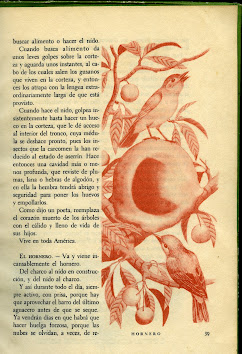 |
| El Tero - Vanellus cayanus |
In 1999, and for a few years, Argentine artists Nora Patrich, Juan Manuel Sanchez and I worked on a joint project that we called Argentine Nostalgia. We worked with a beautiful Argentine woman called Linda Lorenzo.
Our project circled on the rosy past that any expatriate will have. Linda Lorenzo became our canvas for all those memories. One that was dear to my heart was the Argentine bird.
My love for them began on December 7, 1950. I was 9 years old and I know this because the book that was given me on that day of my First Communion has that date.
For the next 3 years my parents would send me to the camp (and Anglo/Argentine word for “el campo”) or the plains we call the pampa. This happened during the hot Argentine summer in January. I would go to remote estancias (Argentine word for ranch).
 |
| December 7 1950 |
It was there that I would ride a horse and gallop in the flat pampa in which the only interruption for a 360 degree horizon was that large tree (not a tree botanically) called an Ombú. I would gallop after what we called avestruces (ostrich) but were really a South American Ñandú.
Both that ñandú and an elegant bird called a tero had the
same protection plan of running away from me as far from their nest as
possible.
 |
| Ñandú - Rhea americanus |
A much more relaxed bird was the plain looking hornero (baker bird) called that because it would build adobe nests shaped like a baker’s oven on the top of fence posts. It had a tight curve to discourage snakes.
 |
| El Hornero - Furnarius rufus |
In one my campo Januaries our host (there were several of us, girls and boys) had a revolver. He would take us to a nearby forest and he would shoot lechusas (owls). It was then when we ate lechuza stew.
One year I brought back a young tero and for a few months he was our guard bird in our Coghlan garden. He would make sounds close to tero-tero. But our large brown poodle broke his wings and we had to put him down.
We also had a South American green parrot called Carlitos who would on any noise made by someone knocking on our gate, he would call out. “¡La basura, la basura!” or “The garbage, the garbage!”
We left him behind in 1953 with our live-in house maid Mercedes Basaldúa. When I returned in 1965 to do my military service in the Argentine Navy, Carlitos was very much alive.
 |
| Federal - Amblyramphus holosericeus |
In 2002 my Rosemary and I took our granddaughter Rebecca who was 11 to Buenos Aires. In a visit to the Buenos Aires Zoo (now closed and gone) I took her to the large cage with a couple of condors. By a stroke of luck one of the birds flew from one end to another and dropped a feather. I was able to retrieve it. I had it framed and gave it to Rebecca as an Argentine souvenir.
It is impossible to describe the sheer pleasure of galloping on the Argentine pampa.
Lucky I was that my parents got rid of me for a month on those Januaries.
The only way I could convey the beautiful red breast of the Federal and satisfy community standards with Linda Lorenzo was to have her pose in a bright red bra.
As in all other languages words in fashion disappear quickly. In the 1950s and 60s a pajarón (literally means a large bird) was used a mild insult that would convey that you were an idiot.









